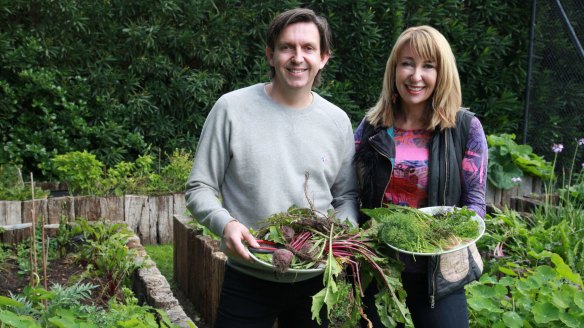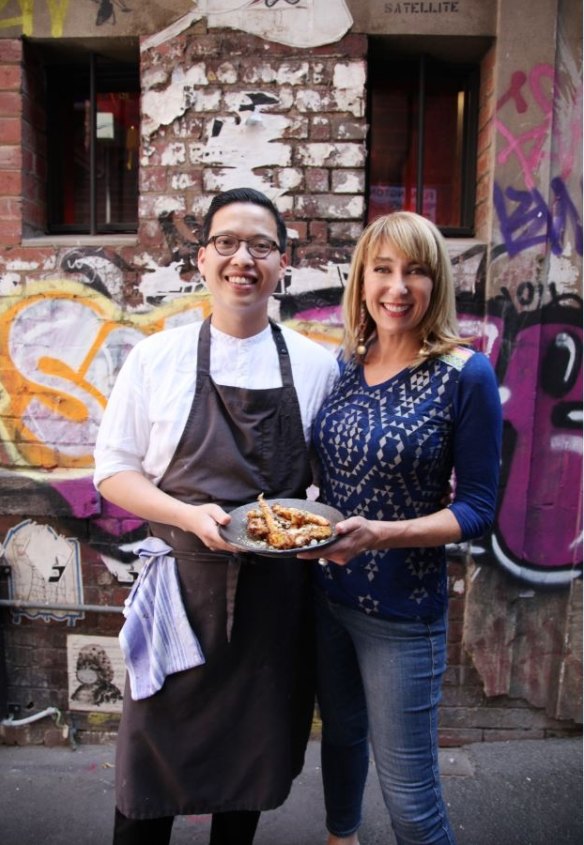Veg out: Maeve O'Meara on why vegetables are taking over our kitchens

It was standing in chef Peter Gilmore's garden, tasting the large delicate petals of Mexican day lilies that I had one of those childlike moments of wonder about the world I'd stepped into.
Here was produce that's not found in the shops - carefully tended varieties of a huge range of vegetables that are part of what the Quay chef describes as his "place of wonderment and imagination". In the early morning peace of his large lush garden with its four 10-metre long raised garden beds there is tasting to be done.
"Look at this," he says, pulling a golf ball-sized kohlrabi out of the loamy earth. "At this size, they're incredibly tender and really beautiful. You've got to explore the different possibilities, so eating these raw – in a salad is gorgeous – as opposed to cooking it."

Like other food alchemists at the top of their game, Gilmore takes a heritage seed catalogue to bed, poring over heirloom varieties of vegetables, exotic herbs, unusual fruit. It's his garden that the inspiration for world-class dishes comes from, where buds and tiny flowers are tasted, where beans of all colours are grown and Mexican day lilies are savoured – their crinkly petals have a light sweet onion flavour and you can just imagine how glorious they'd be in a salad. If vegetables work here, they're grown for his restaurants on a much larger scale.
Among the huge holiday homes on the Mornington Peninsula is another treasured chef's garden that I'm blessed to spend a day in. Andrew McConnell from Melbourne's Cutler & Co, Supernormal and Marion, also cherishes lhours spent in his garden, tasting, imagining and pushing the boundaries. He set himself the task last summer to eat only from the garden. The result – big imaginative salads, vegetables charred over charcoal, roasted in the wood-fired oven, cooked on pizzas. "You connect with the season … dishes I've never cooked before, and I will never again because they are dictated by what's happening out there."
And it strikes me, here are some of our top chefs, world-class chefs all united in their pursuit of excellence with just one food group – vegetables. They are the most versatile food source, sustainable, healthy and seriously beautiful, cheap and clearly the way of the future as we all try to do a meatless meal at least once a week.
The just-picked bounty of the earth is unsurpassed.
The vegetable tipping point
Gilmore reckons 30 years ago the ratio of vegetables to protein in restaurants was 30:70 but is now 50:50. Fellow top chef Ross Lusted from the Bridge Room thinks it has tipped to 60:40 and vegetables will gradually reign supreme. Brent Savage has gone 100 per cent at Yellow in Potts Point and the restaurant is packed. The new black in the kitchen is green and it's here to stay.
Away from top restaurants, delving into how the many cuisines of the world use vegetables cleverly and deliciously opens my eyes to new inspired ways of eating, ingredients, cooking techniques, even festivals celebrating particular types of produce. One of those festivals is the Persian New Year or Nowruz and the sublime kuku sabzi – a delicious herb frittata made with a huge basketful of parsley, coriander, dill and garlic chives, studded with walnuts and barberries.
From Spain comes a great celebration of seasonal vegetables that I can see on the barbecues of Australia. At the end of the grape harvest in Catalonia, the vine cuttings are used to barbecue a leek-like onion called a calcot, which is roasted to black on the outside, its outer layers pulled away and the deliciously sweet long green onion dragged through romesco sauce. Tip your head back, open your mouth and savour one of life's great mouthfuls. Ex-Ortiga (in Brisbane) chef Pablo Tordesillas Garcia loves firing up the coals to recreate this using baby leeks – all you need is a rack to make turning the onions easy – and the aroma of these cooking rivals any steak!
Hotting up
The charcoal barbecue is also the key to unlocking flavour for chef Joseph Abboud from Melbourne's Rumi.
"One of the beautiful things about vegetables is they're full of sugars – when you barbecue them or cook them for a long time the sugars really come out."
He puts eggplant directly onto smouldering coals to blacken and char on the outside, creating a meltingly golden, silky sweet vegetable, which is dressed with tahini, confit garlic, mint leaves and nigella seeds. It's a flavour and texture bomb, as is his spin on the classic fattoush with grilled lebanese grey zucchini mixed with fried flat bread, chickpeas and herbs.
Frugal roots
For many cuisines, the reliance on vegetables and legumes is born of hardship and survival. The sun-drenched countries around the Mediterranean are masters at maximising flavour. In the Greek world, meat was a luxury and Kathy Tsaples from Sweet Greek in Melbourne remembers eating it once or twice a year when she was growing up. Her yemista, using capsicum, eggplant, tomato, potato and onion, are filled with a rice stuffing enhanced with handfuls of chopped herbs and served with a cooking sauce based on the adored Kyknos brand of tomato paste. Bursting with flavour, and with an anointing of olive oil before they're served, they glisten like jewels.
Fasting from meat has created spectacular dishes, especially in the Lebanese world where the national dish kibbe – egg-shaped meat and burghul balls stuffed with minced lamb – transforms into a pumpkin and burghul version with a filling of spinach and wild greens with onion, spices and chickpeas in the hands of my friend talented home cook Judy Saba. My lightbulb moment was how easy it was to mould the kibbe and the joy of making a centuries-old recipe with a friend and her stories of her family gathering to make it and the sheer deliciousness of this vegetable masterpiece.
The thing that has struck me while filming Food Safari Earth is the universal dedication to flavour and tradition.
For instance, Zimbabwean expatriate and mental health educator Dorothy Johnson tells me she grows pumpkin, not for the vegetable, but for its young leaves, tendrils and flowers to make her favourite Muboora une dovi. When she first arrived in Australia she couldn't wait to plant her pumpkin seeds and the tall white maize she grows to make sadza, a polenta-like accompaniment to everything.
"I've brought Zimbabwe with me" she says.
Backyard flavours
So many cuisines prefer to make their own ingredients – passata, pomegranate molasses, coconut milk, kimchi – and it's a revelation to see these come together in the backyards of the nation. On a sunny Sunday under gum trees on the NSW South Coast, Turkish chef Somer Sivrioglu from Sydney's Efendy and fellow chef Arman Uz make their own pepper paste (biber salcasi) using bullhorn peppers. "Some guys go hunting – we make pepper paste!" he laughs. The peppers are minced, cooked in a big pot over a fire and then spread in a wide flat dish to dry in the sun for four days. This is what gives the flavour boost to so many dishes, including the Istanbul street food favourite mercimek kofte made with red lentils, herbs, spices and served sang choy bao-style in baby cos lettuce.
I now appreciate beautiful loamy earth in a way I never have before. For a city person used to buying supermarket vegetables, sometimes wrapped in plastic and on polystyrene trays, the glorious abundance of the just picked bounty of the soil is unsurpassed. I have "farm envy" when I visit Boon Luck Farm in the Byron Bay hinterland – an enterprise for Thai restaurateur and chef Amy Chanta and her daughter Palisa Anderson whose dream was to grow everything they needed, including many types of eggplant yet to be seen in stores, exotic herbs, chillies and vegetables. Switch to another farm in the western suburbs of Sydney and I feel like I'm back in Vietnam visiting the green fragrant paradise of a huge exotic herb garden, the workers in conical hats under shade cloth harvesting neat green rows of perilla, thai and lemon basil, coriander and more. This is a rich and varied world full of possibility and excitement.
And I now have new addictions – plantains sliced with a mandolin (skin on) made by charming young Colombian chef Oscar Espinosa – popped into acidulated water and then fried, these make delicious sculptural chips; Victor Liong's inspired use of eggplant in chips that are battered and served with a spicy vinegar sauce; Lusted's pairing of celeriac and truffle to create a symphony of deep earthy flavour and Ibrahim Kasif's ode to spring with whole baby broad beans cooked in the pod with tomato and olive oil. As we stuff the pumpkin kibbe, my friend Judy Saba remembers her mother's favourite phrase: "The best meal is the one made wholly from what the earth yields."
Food Safari Earth is a 13-part series exploring how multicultural Australia cooks with the bounty of the earth. From hatted-restaurant head chefs to authentic home cooks, Maeve O'Meara uncovers the endless possibilities of cooking with fresh vegetables, exotic fruits, herbs, grains, pulses and flowers. Food Safari Earth, 8pm, Thursdays on SBS until January 4, 2018.